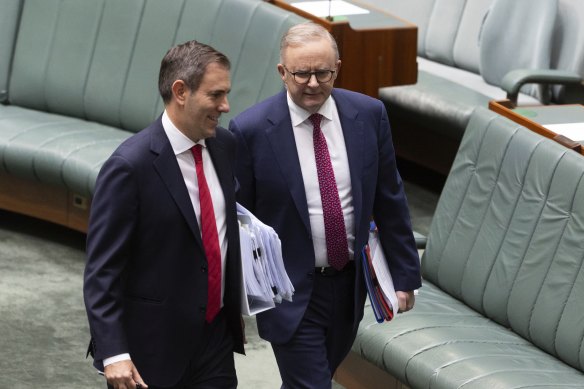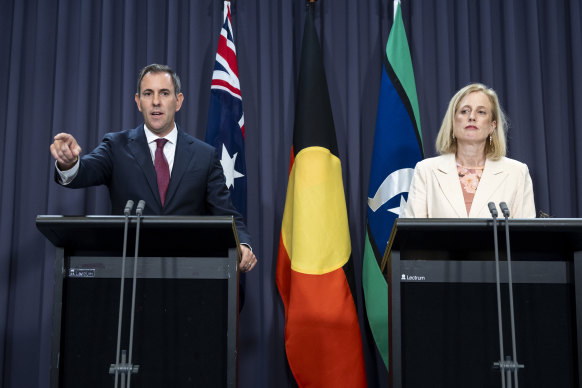This was published 11 months ago
Six simple words that could fire the gun on the next election
The federal budget, if you pay close attention, could reveal Labor’s hand – and its plan to be sensible but boring.

Credit: Stephen Kiprillis, Dion Georgopoulos and Bloomberg
Deep inside the pages of Jim Chalmers’ third federal budget, six simple words could give Australians a big hint about whether an early election could be held later this year.
Those words – “decisions taken but not yet announced” – are a regular favourite of budget watchers. Last year’s budget contained $7.8 billion in payments under this heading, and while some of those were commercially sensitive matters, a big chunk of it was energy bill relief for households.
Already, we have some “known unknown” measures that will be announced on May 14: more energy bill relief, help for people hit by big increases in their HECS debts, extra money to tackle domestic violence and more road and rail spending.
The government is now putting the finishing touches on its principal economic document. Fights between the ministers and the Dr Nos of the expenditure review committee, including Chalmers and Finance Minister Katy Gallagher, are winding up.

Treasurer Jim Chalmers and Prime Minister Anthony Albanese.Credit: Alex Ellinghausen
Budgets are a statement of political values and intent that can make or break governments. Everything in this budget will be framed within the government’s overarching “Future Made in Australia” message and the fact it is putting more money in people’s pockets through the stage 3 income tax cuts.
If the section in budget paper 2 about “decisions taken but not yet announced” is bulging with cash for future announcements – or there’s a fistful of dollars for road, rail and industry investment in the vital swing states of Western Australia and Queensland – then budget 2024 will have fired the starting gun for an early poll, providing that a few other economic pieces fall into place.
Prime Minister Anthony Albanese has said his government is likely to have one more budget in it, in March or April next year, before the three-year anniversary of the 2022 election rolls around.
But some senior figures in the government are saying privately the chance of an election in 2024 is as high as 50-50.
As one Labor insider puts it: “If we get a good result with a rate cut in November, surely we’d be thinking about pulling the trigger [this year]? Once that first rate cut comes, people know it won’t be the last.”
All federal budgets are a delicate balancing act, but this one more than most: it must contain sweeteners, to help households reeling from the spiralling high cost of living, but it can’t be too sweet, or it will push up inflation and delay interest rate cuts.
Make no mistake: Labor strategists have their fingers and toes crossed that interest rate cuts come, and this year. This will have a huge bearing on the timing of the poll.

Treasurer Dr Jim Chalmers and Finance Minister Katy Gallagher.Credit: Alex Ellinghausen
Out to win votes, already?
Potential vote-winning ideas like a big new scheme to fund households installing solar power and batteries look likely to be held back until closer to the election, to ensure maximum bang for buck.
In a major speech this week, Chalmers outlined the case for carefully targeted co-investment in nascent industries and fiscal prudence, rather than a big cash splash on a range of Labor-friendly measures. So far, so cautious.
More strategically leaked budget details will occur over the next week.
Another Labor MP familiar with the prime minister’s thinking, who asked not to be named, sums up the budget strategy like this: “Albo’s intention is to have a budget next March and an election after that. But he hasn’t written off going earlier, and why would you?
“The teals are now organised. The panic regarding inflation was ridiculous, it’s still moderating, and we can still produce a second surplus,” the MP says.
“Do we think we will lose? No, but we aren’t taking it for granted. Would I rather be us than them? Yes. They aren’t even trying to win back the teal seats to get a majority. The only people who can realistically form a stable, majority government is us.”
The Coalition’s mammoth task
The road back to majority for the Coalition after just one term is difficult. It needs to win 21 seats to scrape together the barest majority of 76 seats, and the last one-term government was James Scullin’s, which fell in 1932.
Historically, governments suffer a swing after their first term in power, a trend that has accelerated in recent decades, and Labor starts with just 78 seats, while electoral boundary redistributions in WA, Victoria and New South Wales later this year are expected to hand the Coalition one extra notional seat.
Many analysts from both parties calculate a minority Labor government is the most likely outcome, whenever the poll is held. Timing is complicated by a slew of elections overseas (the United States in November and the UK by the end of the year) and at state level (Queensland in October, WA in March) that would chew up voter bandwidth.
As one party strategist observes, there is a small window in late November or early December 2024 in which Queensland voters could have vented their spleen on the state government, the US election will be done and federal Labor will have clear air to go to the polls. After that, you’d be looking at next May.
Which brings us back to the budget and its impact on the timing of the poll.
The big risk for Labor
The persistent threat of high inflation outside the Reserve Bank’s 2-3 per cent target band is front of mind for Labor – the longer inflation is high, the longer it will be before the central bank starts cutting the cash rate that sets Australians’ mortgages.
But senior government figures are more optimistic about the central bank’s next move being an all-important cut.
And they believe Opposition Leader Peter Dutton’s relatively threadbare policy offerings, once they are beefed up with details of its alternative plans for nuclear power and to help first home buyers, will offer opportunities for the government to criticise the opposition.
The task right now is this: if Labor spends too much, too soon, in this budget then it risks the dual charges of being economically irresponsible and fuelling inflation (a charge the opposition is already making).
Surpluses have become political shorthand for solid economic management (though most economists will tell you this isn’t actually the case) and Deloitte Access Economics this week forecast a $13.4 billion surplus.
Chalmers and Albanese want to reclaim the mantle of Labor being better economic managers – so the focus right now is on handing down that second consecutive surplus.
The underlying message is clear: trust us, we are sensible and boring.
Whenever the election campaign rolls around, Albanese and Chalmers are not going to be taking questions about the fact his first budget forecast the free on-board price of metallurgical coal (for example) would decline from USD$271 a tonne to $USD130 and instead rose to USD$342 by the second budget – helping deliver the first surplus in more than a decade.
They will simply argue they have delivered a pair of surpluses after a decade of deficits under Tony Abbott, Malcolm Turnbull and Scott Morrison – and that Labor can, once again, be voted in as the stable, natural party of government.
Establishing Labor as the “no surprises” party of government is core to Albanese’s mission.
Cut through the noise of federal politics with news, views and expert analysis from Jacqueline Maley. Subscribers can sign up to our weekly Inside Politics newsletter here.